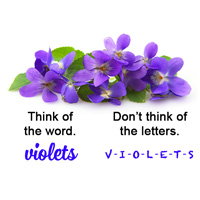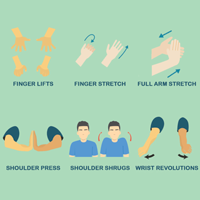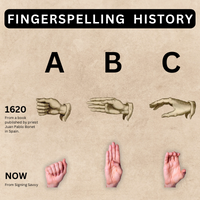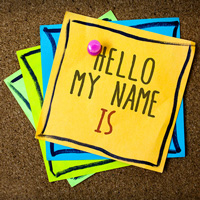What is Fingerspelling?
The Manual Alphabet
The alphabet signs used in ASL are called the manual alphabet. The manual alphabet consists of 26 individual handshapes corresponding to each letter of the English alphabet.

Signing Savvy Member Feature: Download this image / flyer as a printable PDF page.
Fingerspelling
Fingerspelling is an important part of American Sign Language where individual letters of the manual alphabet are signed to spell out English words.
Fingerspelling has various but specific uses within ASL:
Proper Nouns
Proper nouns such as the names of individual people or organizations are fingerspelled. For Example:
 |
Titles
Titles of things like books, plays, movies, and television shows are fingerspelled.
You can see how both the person’s name “Howie Seago” and the name of the TV show “Star Trek” are fingerspelled in this example sentence:
English: Howie Seago is a deaf actor and director. He is famous for many roles including acting on Star Trek.
ASL Gloss: H‑O‑W‑I‑E S‑E‑A‑G‑O HIMSELF DEAF ACTOR DIRECTOR. HE FAMOUS MANY ROLES INCLUDING #TV PROGRAM S‑T‑A‑R T‑R‑E‑K.
Specific Terms
There is not a sign for every English word. Fingerspelling is used to indicate a specific English word for something when there is not a sign.
For example, there is a sign for BIRD, but if you want to specifically say PARROT, you would fingerspell it since there is not a sign for it. Another example is that you can sign STARS, but if you want to specifically say CONSTELLATION, there is not a sign, so you would fingerspell the word.
 |
When Clarification is Needed
If someone does not understand the sign you used — fingerspell it. When you don’t understand a sign someone else used — ask them what they mean and have them fingerspell it. If a sign is used that has a broad meaning and clarification is needed — fingerspell the specific term.
Practicing Fingerspelling
Practicing the alphabet straight through is beneficial when you are first learning the letters, but do not just practice the alphabet in order over and over. Once you are exposed to each letter, start practicing full words. Fingerspelling is more than just individually signing each letter in a precise manner; the letters within words should flow together. The more you fingerspell, the more you will develop a rhythm and pacing to your fingerspelling. We like to equate fingerspelling to penmanship — it should be beautiful to watch.
A great way to practice is by fingerspelling pangrams since a pangram is a sentence that contains all 26 letters of the alphabet.
Here is an example of fingerspelling a pangram:
English: The quick brown fox jumped over the lazy dogs.
ASL GLOSS: T‑H‑E Q‑U‑I‑C‑K B‑R‑O‑W‑N F‑O‑X J‑U‑M‑P‑E‑D O‑V‑E‑R T‑H‑E L‑A‑Z‑Y D‑O‑G‑S.
Writing Fingerspelled Words
You cannot communicate with ASL through written text. ASL has no written form. It has become standard practice to refer to a sign in writing by using all capital letters (CHOCOLATE) and a fingerspelled word by all capital letters separated by hyphens (S‑N‑I‑C‑K‑E‑R‑S). You will also see it written this way in the sign descriptions throughout Signing Savvy. For example:
English: I love Bob.
ASL Gloss: I LOVE B‑O‑B.
Lexicalized Fingerspelling
There is a special subset of fingerspelling referred to as lexicalized fingerspelling. Lexicalized fingerspelling is fingerspelling that looks like a sign. The individual letters blend together, form a shape, or have a movement like a sign, rather than being composed of just the individual letters. There are only certain words that are lexicalized. You will not know which words are lexicalized when you are just beginning to sign. That’s okay; it is safe to fingerspell any word and people will understand what you are signing. As you become more experienced and communicate more with fluent signers, you will learn more words that are fingerspelled in a lexicalized fashion. For example:
 |
 Brenda Cartwright is a seasoned interpreter, a master teacher, well known presenter, and author of several best selling sign language and interpreting textbooks from the RID Press. For 35 years Brenda was the Chair of the Sign Language Interpreter Program at Lansing Community College in Lansing, Michigan.
Brenda Cartwright is a seasoned interpreter, a master teacher, well known presenter, and author of several best selling sign language and interpreting textbooks from the RID Press. For 35 years Brenda was the Chair of the Sign Language Interpreter Program at Lansing Community College in Lansing, Michigan. Tips When Starting to Fingerspell
Tips When Starting to Fingerspell Fingerspelling Warm-Up Activities to Prevent Repetitive Motion Injuries
Fingerspelling Warm-Up Activities to Prevent Repetitive Motion Injuries Fingerspelling History
Fingerspelling History






